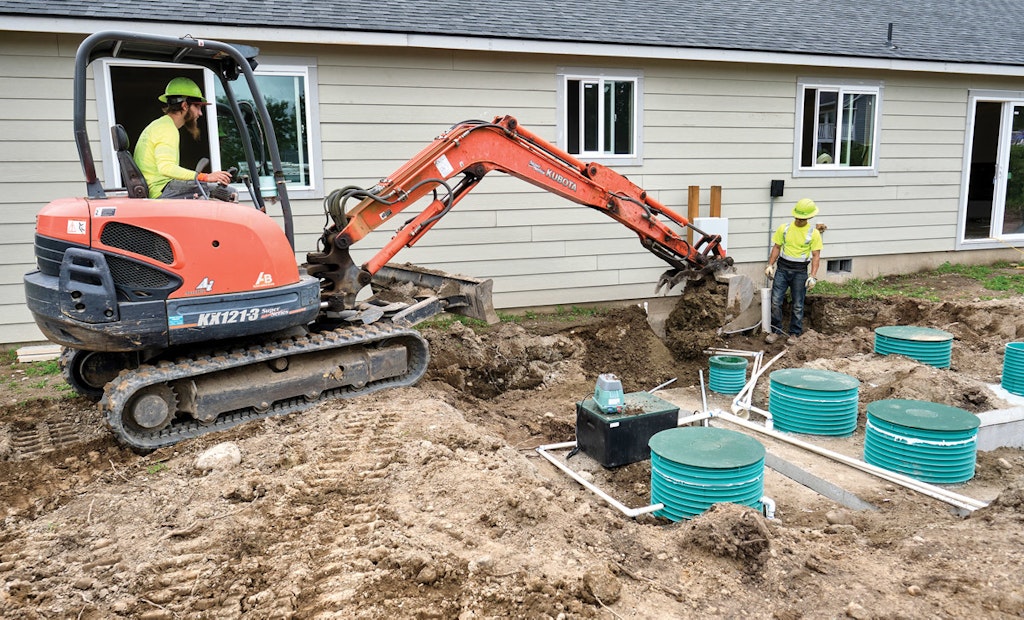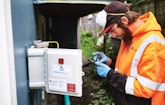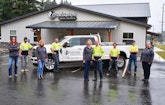
Using a Kubota excavator, operator Kale Klitzke fills in around a new onsite system incorporating an OSCAR (Onsite Sand Coil Area Recharge) system from Lowridge Onsite Technologies and a NuWater aerobic treatment system from Enviro-Flo. Technician Diaz Griffin watches.
Jen Chapin got an interesting introduction to her husband Alan’s new onsite installation business. It was the day he brought home the equipment he had just bought.
“I said, ‘You just quit your job. You drive up with a truck, trailer and Kubota in our driveway, and you’re doing what?’ And then, ‘I guess you’re going to need an office assistant.’”
That was 14 years ago. Today their company, Envirotek Septic Solutions on Washington’s Camano Island, does a thriving business with 10 team members, providing installation and repairs, pumping and inspection.
Alan started the company with a vision for doing things differently — meaning better — than he had often observed after 17 years on the manufacturing, sales, design and management sides of the onsite industry. He had no hands-on installation experience but did have a desire to give every customer a high-quality system.
“I want to make sure the customers’ systems last as long as possible,” he says. “The only way to do that is to use better products and better methods of putting things together — making sure everything is done correctly.”
That approach has bought excellent word-of-mouth and an abundance of repeat business. The customer connections are enhanced by the company’s “On Septic” educational programs offered twice a month for homeowners, real estate agents and others in the company’s training room.
SEEING ALL SIDES
Alan Chapin started out after high school working in manufacturing with Orenco Systems in Sutherlin, Oregon. After five years, he moved to Washington and joined Orenco distributor HD Fowler. While there, he advanced from customer service to sales and ultimately management.
After three years, he moved back into sales, supplying the onsite installers who in many cases are now his competitors. In 1996, with his employer’s permission, he earned a designer’s license and began designing systems on the side.
By 2006 he was ready to launch a business. “I started inspecting and then immediately bought an excavator, a trailer and a truck and went right into installing,” he says. “I had experience with all the products, and I had experience watching guys doing the work in the field. I just basically said, ‘I can do that.’”
Meanwhile, a friend and former customer was moving to Arizona; Alan was able to take over his accounts. “That gave me a foot in the door to have some business right away. He showed me how to do installations; I learned from him before he moved away.”
The business took off quickly, Jen recalls: “We created an office in the house. We became so busy that I had to quit my physical therapy assistant job to help run the business. About three years into it, we started hiring employees.”
Today the team includes Kim Mahoney, chief operations officer; Monte Larsen, lead pumper; Chris Hinds, pump technician; Kale Klizke, lead installer; Cruz Griffin, install technician; Michele Thompson, bookkeeper; and Pam Murdoch, agreement services. They also have a new hire: Angie Hines, customer service/bookkeeper.
AIMING HIGHER
Camano Island, about an hour north of Seattle in Puget Sound, is about 18 miles long and 3 miles across. It has about 15,000 full-time residents and up to 18,000 in summer; the population is growing quickly. The entire island is served by septic systems. Envirotek reaches out to a 70-mile radius from home base, covering Island, Snohomish and Skagit counties.
During his years in the business, Alan saw ways to improve on installation practices he had observed. He was determined to clean up construction scrap and carry it away instead of burying it the septic tank hole. He vowed to use the highest-quality components and take extra steps to ensure sound, leak-free systems.
“It’s wet here in the Northwest,” he says. “One thing we do is seal all penetrations, not only on the inside but also on the outside, so that water has no chance of ever infiltrating the system. That’s a big detail, because a lot of failures happen due to hydraulic overload. It’s not a lot of extra time, and it’s very little extra money to go that extra step. For me, $3 of bentonite as opposed to just epoxy seems like good insurance.”
Install crews use clear polycarbonate sight tubes to test and fine-tune pressure distribution for new and existing systems. They install clean-outs at the lateral ends and use threaded fittings to fasten the tubes, which stand about 5 feet out of the ground. “Now when we run the pump we can clearly see where the liquid level is in all those sight tubes,” Alan says. “We place a little orange ball inside so we can see the water level from a distance, because that ball is floating.”
Quality practice also extends to the pumping side, and it starts when a customer calls the office. Jen says, “We tell them what we’re going to do verbally, and then they get a confirmation letter. We send out our qualified technicians with our high expectations, and we follow up afterward. It seems to work out well.”
Alan adds, “We don’t park in the driveway. We run extra hoses. We have two people on site so we can always protect the landscape. It’s not about getting in and out as quick as possible. We take a little more time and make sure the tank is clean when we leave.”
THE RIGHT STUFF
The pursuit of excellence emphatically includes the selection of team members. “We have a long process to hire the right person,” Alan says. “We don’t hire just to fill a hole or a gap. Our core values are excellence, generosity and enthusiasm. People need to have those at a minimum to work here.”
Jen spearheads the hiring process, which includes phone interview screening, a face-to-face interview with her, a group interview with the two owners and Mahoney, followed by a two-hour in-the-field interview to give the prospect a taste of life on the job.
“Yes, it’s a lot of work,” Jen says. “But we know it makes a difference to our customers and our employees. Often the first thing a new employee says is, ‘Wow, it’s different around here.’ It’s the high level of expectation for how we take care of the customer and the way we treat each other and hold each other accountable.”
Alan adds, “Our ratio of say-do is one-to-one; if we say it, we do it. That is standard operating procedure for everybody. If they say they’re going to do something, they make sure that it happens. Customers don’t get disappointed because they didn’t get what they were promised. Our employees are the reason we get so much repeat business.”
DIVERSE PORTFOLIO
New and repeat business cuts across all sides of the operation. Diversification developed naturally. “I always think, how can I improve on what’s being done,” Alan says. “From installation and inspections, I thought, If a customer needs a tank pumped, who’s going to pump it? We used to refer a lot of work to pumpers. It took us awhile to add a pump truck because of the cost, but eventually it got to a point where we could add that service.
The company now owns a 1991 International vacuum truck with a 2,300-gallon steel tank and a Masport H15X pump, from Erickson Tank & Pump; and a 2012 International DuraStar with 1,870-gallon steel tank and a Jurop/Chandler PN84 pump, from KeeVac Industries. The company pumps about 600 tanks per year.
On the installation side, the go-to machines are three Kubota excavators: a 2006 Model KX121, 2010 Model KX41 and 2018 Model KX008. System volume ranges from 50 to 75 per year. Challenges include beachfront properties with cabins being converted from seasonal to full-time occupancy, for which the existing septic systems are inadequate.
Tank installations there have to be coordinated with low tides. “Because we’re dealing with sand and gravel, the holes, you start out with a normal tank hole, but it ends up being three times the size because of tides and the collapsing of the sand,” Alan says. Tanks typically go on the back side of the house and the drainfield on the beach side beyond a mandatory 25-foot setback from the ordinary high water mark.
Other sites have steep slopes that require drainfields to follow the land contours. Camano Island has areas with shallow hardpan and others with water tables as little as 12 inches below ground. These sites are well suited for OSCAR (Onsite Sand Coil Area Recharge) systems from Lowridge Onsite Technologies, low-profile treatment and dispersal systems that require only 12 inches of soil above water or a restrictive layer. The company also installs NuWater aerobic treatment units (Enviro-Flo).
For septic tanks, Alan prefers plastic units from Infiltrator Water Technologies. “We use concrete when we can easily get the truck that’s delivering the tank into the site,” he says. “We prefer plastic because we don’t need to have the tank hole ready to go when the truck shows up. Plastic gives us more flexibility, but we are somewhat more selective in high-water-table areas.”
For drainfield media, the company uses only chambers (also Infiltrator).
GIVING BACK
While building its business, Envirotek has worked to expand community members’ knowledge of onsite treatment and its environmental benefits. On Septic programs held twice per month typically attract 15 to 20 people. Flags posted outside the office, which is on a main road through the island and across from the building that houses the county health department, let residents know about the events.
“Community is important to us,” Alan says. “We give back to the community by sharing our knowledge to help homeowners take care of their systems so that they will last for as long as possible. We want them to be educated, so that even if they hire somebody other than us — which is totally fine — they’ll know what to look for, they know the right questions to ask.”
Programs cover topics like when to pump a tank, how to landscape around septic systems, what to do during home sale inspections, the pros and cons of additives and many others. “It never has been and never will be a sales pitch,” Alan says. “We never disparage our competition. We say, ‘Here’s what you should expect from this service. We want you to be better prepared.’” Handouts are prepared for each topic; attendees receive a binder that they can fill up with information as they take part in more sessions.
Cindy and Don Horton attend the sessions regularly. They bought a house on Camano Island last year and had no experience with septic systems. While driving one day, they saw the sign at Envirotek. They attended for the first time in October.
“We’ve been going to them ever since,” Cindy Horton says. “They are spectacular. I’m a former teacher, and I really like a great presentation. These are above and beyond anything we could have expected. Alan is so informative and knowledgeable about all the different kinds of systems. He has a way about his presentations. There’s a little bit of humor, a little bit of science, a little bit about a lot of things. That makes it really interesting.”
It’s a great way to create an informed clientele and to spread an environmental ethic among septic system owners on and around Camano Island.
Humble, hungry, smart
Alan and Jen Chapin of Envirotek Septic Solutions on Camano Island, Washinginton, hire people more for personal qualities than for experience and skills.
The attributes they look for boil down to three words: humble, hungry and smart, as prescribed by business consultant Patrick Lencioni. “You can always train for skills,” Alan says. “Hiring people with those attributes will ensure a better chance for success as a team.”
Humble is not about thinking less of oneself, Alan observes. “Having humility in a team context is more about thinking of others. It’s a mindset that if I’m going to do or say something, I want it to add value to my team and to my customer. It’s thinking about how to add value for someone else instead of thinking, ‘What’s in it for me?’”
Hungry means having a focus on finding a way. “We don’t complain,” Alan says. “We don’t act like victims. We’re going to find a way to make it happen with the resources and the people we have here. That may mean staying late and coming in early. It’s having a sense of excitement about the work we’re doing.”
Smart “doesn’t mean book smart,” Jen says. “It means can you work with other people? Do you know how to communicate with them? It’s knowing what to say and when to say it, knowing how people feel in a meeting or in a room.”
These attributes in all team members help Envirotek create an experience that customers appreciate and remember.











